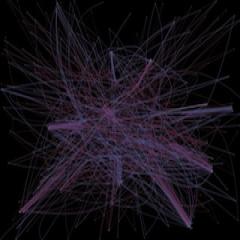Michael Edgcumbe
Michael Edgcumbe
A Reynolds flocking system is used to induce a meditative state from which insights into data sets mapped onto the behavior of the agents may be gathered.
http://www.noisederived.com

Classes
Project Development Studio (Danny Rozin)
Project Development Studio (Danny Rozin)
Data visualization has yet to offer novel methods to gain insight into complex data. Fortunately, Daniel Shiffman's the Nature of Code teaches students new ways to organize visual information. A flocking system offers a path to an integrative, intuitional response to data that would otherwise be reduced to the inherent limitations of traditional statistical analysis.
For example, in one visualization, responses of a survey distributed by the World Economic Forum are mapped to behavioral aspects of a flocking system to reveal patterns of interest through the observation of agents in action.
The weighting is based on aspect of the survey answers.
- If the council is interested in the other council, the agents attract each other.
- If not, they repel.
- Agents from the same council align their movements
- Agents from the same type of council have cohesive movements
- The color is the type of council
- The speed of movement is based on the type of organization, i.e. business vs. government
- The maximum force of movement is based on the ranking of answers in the survey
Particular attention is paid to the aesthetic quality of the flocking system. They should stand in contrast to the emotionless calculations often on display in standard graphs and charts. The participant views the system in three dimensions. Relaxing into the visualization may reveal key elements.
Background
http://www.shiffman.net/teaching/nature/
http://www.visualizing.org/challenge/world-economic-forum-data-visualization-challenge
Audience
Decision makers with access to complex data. Potential owners of 3d televisions and monitors.
User Scenario
A participant stops to consider the patterns of behavior present in the visualization. Rather than making comparisons between slices of data, the participant gains emotional insight into how he or she feels about the agents.
Implementation
Processing and OpenGL displayed on a 3D TV. Fed by a database built from comma seperated value files containing responses to survey questions.
For example, in one visualization, responses of a survey distributed by the World Economic Forum are mapped to behavioral aspects of a flocking system to reveal patterns of interest through the observation of agents in action.
The weighting is based on aspect of the survey answers.
- If the council is interested in the other council, the agents attract each other.
- If not, they repel.
- Agents from the same council align their movements
- Agents from the same type of council have cohesive movements
- The color is the type of council
- The speed of movement is based on the type of organization, i.e. business vs. government
- The maximum force of movement is based on the ranking of answers in the survey
Particular attention is paid to the aesthetic quality of the flocking system. They should stand in contrast to the emotionless calculations often on display in standard graphs and charts. The participant views the system in three dimensions. Relaxing into the visualization may reveal key elements.
Background
http://www.shiffman.net/teaching/nature/
http://www.visualizing.org/challenge/world-economic-forum-data-visualization-challenge
Audience
Decision makers with access to complex data. Potential owners of 3d televisions and monitors.
User Scenario
A participant stops to consider the patterns of behavior present in the visualization. Rather than making comparisons between slices of data, the participant gains emotional insight into how he or she feels about the agents.
Implementation
Processing and OpenGL displayed on a 3D TV. Fed by a database built from comma seperated value files containing responses to survey questions.

